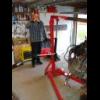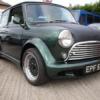Hi all,
i have filled a piece of my quarter panel after doing a welding job
so my question is how do i get the smooth surface finish , i have heard that to
rub down with wet and dry paper and to dip it into a bucket of water and rub down the filler
but i heard also that filler is pourus
The last thing i want is water getting at the panel behind becusce of rust
can anyone point me in the rigth direction with this
Thanks

Getting That Smooth Filler Finish
Started by
087dave
, Jan 31 2012 08:09 PM
8 replies to this topic
#1

Posted 31 January 2012 - 08:09 PM
#2

Posted 31 January 2012 - 08:12 PM
Whatever you do do NOT go near it with water!!! As you have said filler is porous so will lead to your paint going weird either at time of painting or after.
Dry sand with sandpaper of gradually smoother grades up to about 320 grit. My whole car was just done by a pro body shop which included a few bits of filler in bits I was smoothing off and they used 320 for a final once over to get it to paint stage.The paint layers will hide any small marks the 320 leaves :)
Dry sand with sandpaper of gradually smoother grades up to about 320 grit. My whole car was just done by a pro body shop which included a few bits of filler in bits I was smoothing off and they used 320 for a final once over to get it to paint stage.The paint layers will hide any small marks the 320 leaves :)
#3

Posted 31 January 2012 - 08:21 PM
If you have a compressor use a DA sander to rub any filler back. I start with 180 grit then progress up to 300/400. Once you have gone over it to your satisfaction give it a good coat of high build primer then flat that back. Now give the area a guide coat (just some black paint sprayed on finely) to see where your high and low points are if any. Sand back until you have only some low spots then apply another skim of filler to remove any low points then flat back with some 600 wet and dry or the DA sander.
If the surface is still a little rough then apply some more high build primer but only on small imperfections, anything really noticeable will need another skim of filler.
If the surface is still a little rough then apply some more high build primer but only on small imperfections, anything really noticeable will need another skim of filler.
#4

Posted 31 January 2012 - 08:22 PM
Use dolphin glaze on the final fill, its a self leveling polyester putty. Its the dogs danglies at getting the smoothest finish. It will still need rubbing down tho, its just a lot finer than normal filler and will stop you getting fish eyes in your paint.
#5

Posted 31 January 2012 - 09:43 PM
Others may well disagree with this, but I have always used wet & dry paper paper, wrapped around a sanding block and dipped in water. It makes for a smoother finish and also and stops the wet and dry paper from becoming clogged with filler/paint residue. I've always got good results using this technique and have never yet had a subsequent problem with corrosion beneath. I do tend to use a hair dryer on the area afterwards though, to make sure that it is thoroughly dry before painting over. 
#6

Posted 01 February 2012 - 08:59 AM
take the top off with 80 grit production paper with a sanding block, then finish off using 180 w&d and then final finish with 320 w&d, then use primer, when dry as above use a putty type filler., when set rub down with 380 w&d and if needed more paste/putty for pin holes or low areas and rub down and then prime.
use a hair dryer/heat gun every time you have used water with the w&d to dry the filler/putty.
fish eyes are caused by silicone so using a putty will not stop it.
use a hair dryer/heat gun every time you have used water with the w&d to dry the filler/putty.
fish eyes are caused by silicone so using a putty will not stop it.
#7

Posted 05 February 2012 - 07:50 PM
I always use an infared lamp because it heats the surface from inside out, so dries any wet or damp that has got into the filler from the inside before I paint the surface, not had any micro blistering using this method up to now
#8

Posted 06 February 2012 - 05:51 PM
shape it with 80 grit, finish with 180. 2 coats of high build primer flat this with 320, if required re primer of top stop, if ok top coat if its too flat the primer wont stick to it
#9

Posted 06 February 2012 - 06:15 PM
Block sanding is the best way to get the filler to match the contour of the body. Starting with the coarser grain, always sand in a back and forth motion along the same plain, not in a circular motion. When changing to a finer grade paper again sand in a back and forth motion but perpendicular to the motion used for the coarser grade. Constanly check that you have not removed to much filler when sanding otherwise you wil have to start again. The better finish you get at the filler stage the less high build primer you will need.
I always dry sand filler using 120, 160, 240 and 320. At the primer stage again dry sand using 320, 400, then finish with 600. If you panels are clean of grease and you filler and primers are cured properly you should have no problems with clogging paper.
I always dry sand filler using 120, 160, 240 and 320. At the primer stage again dry sand using 320, 400, then finish with 600. If you panels are clean of grease and you filler and primers are cured properly you should have no problems with clogging paper.
1 user(s) are reading this topic
0 members, 1 guests, 0 anonymous users


















